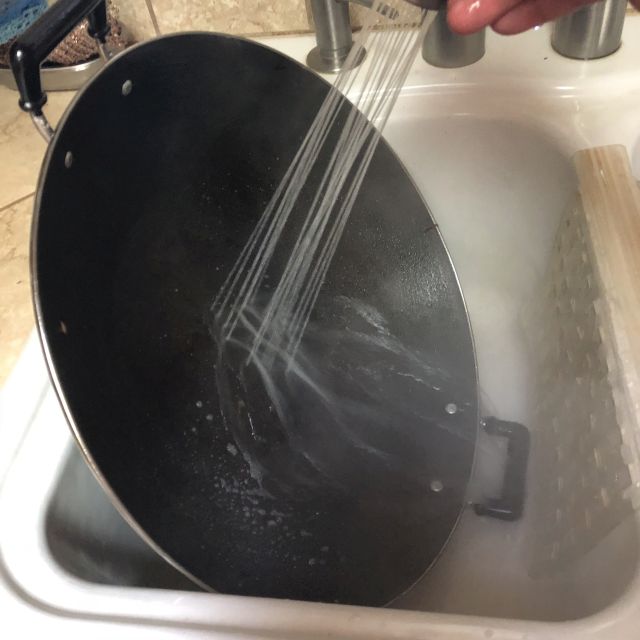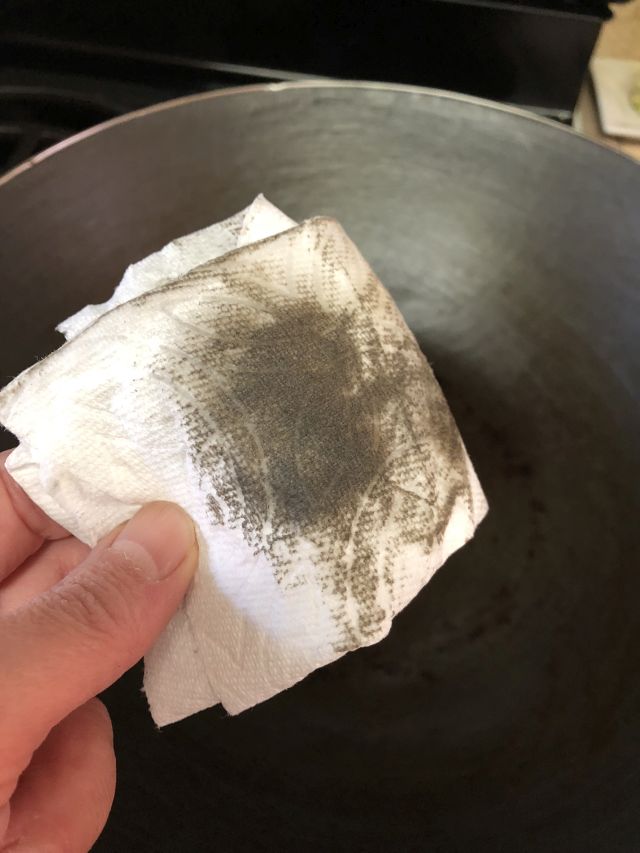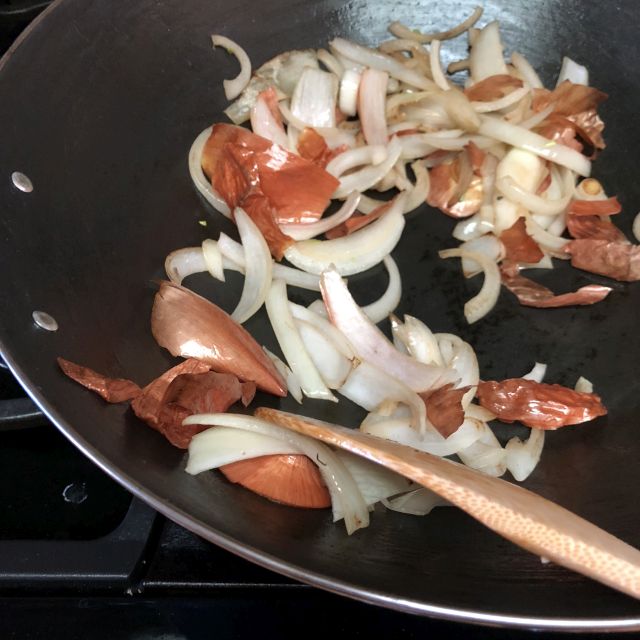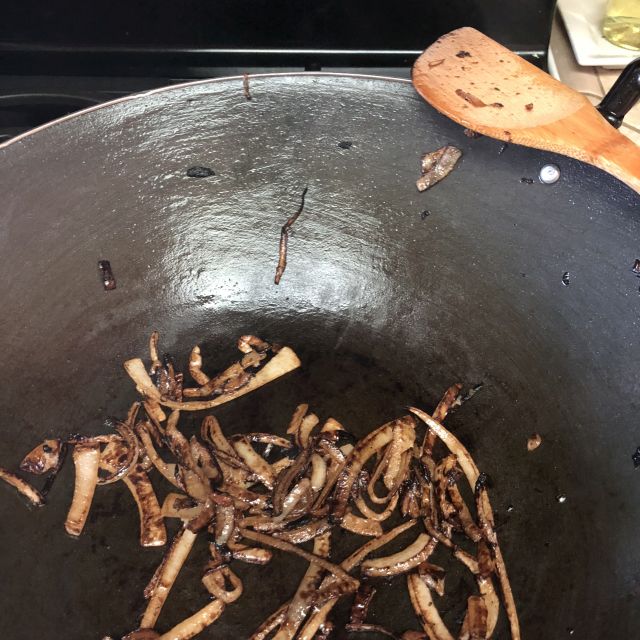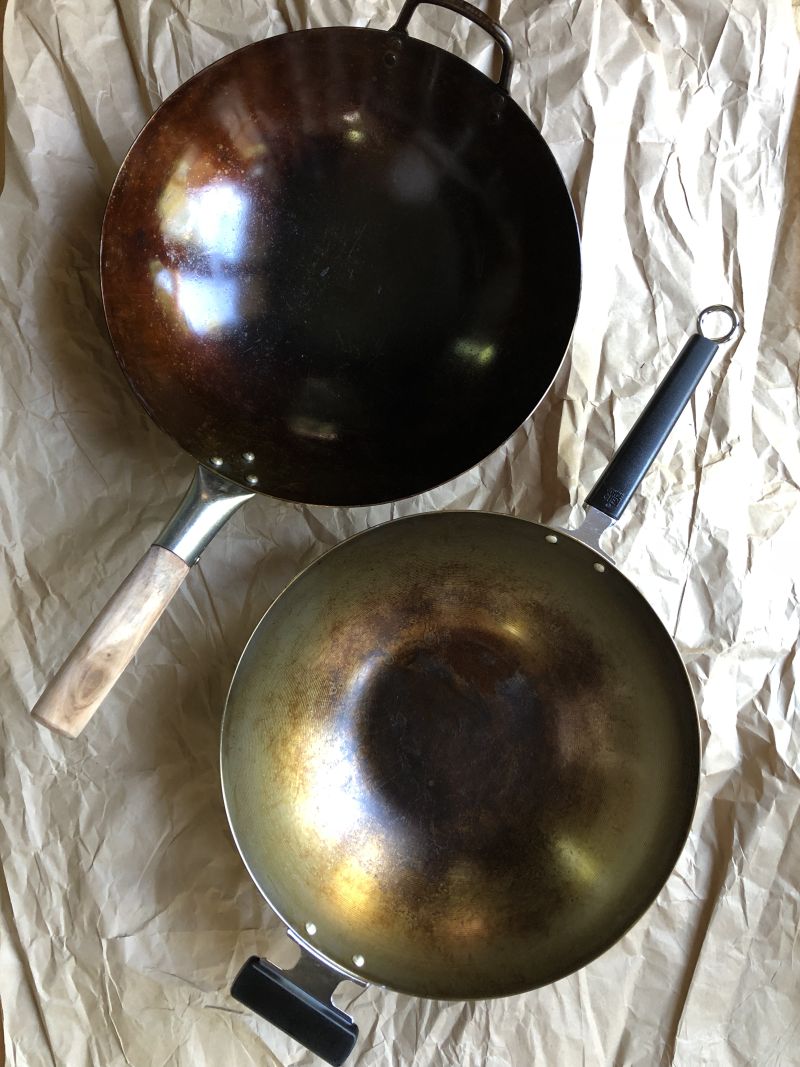
A wok that’s well maintained can be a friend for life. But like all relationships, you want to start things out right. If you’ve purchased a new carbon steel or cast-iron wok like one of those mentioned in the wok buying guide, you need to season it before you set out on your maiden voyage to cook something delicious. How to season a wok? It’s simple to do, and you have options.
Over the years, I’ve tried three different wok seasoning methods. My experiences may help you choose how to clean and season your wok.
Cleaning the Wok
Set aside time to clean the wok of machinery oil used during manufacturing. If a wok comes with specific cleaning instructions, follow it. This initial cleaning is seldom a relaxed thing. Expect to involve vigor.
Tackle the first cleaning this way: First, scrub the pan with soapy water. Wear gloves and use a scouring pad. Dishwashing soap is fine at this point. If dark machine oil runs off, spray on a cleaner such as Simple Green to remove it.
If the wok has a waxy or lacquer-like coating that doesn’t come off with scrubbing (see below from the Joyce Chen carbon steel wok), fill the pan three-quarters full of water, add 1/4 cup salt or baking soda and boil for 10 to 15 minutes; after the coating lifts off, turn off the heat, cool a few minutes, then carefully empty the wok and wash it.
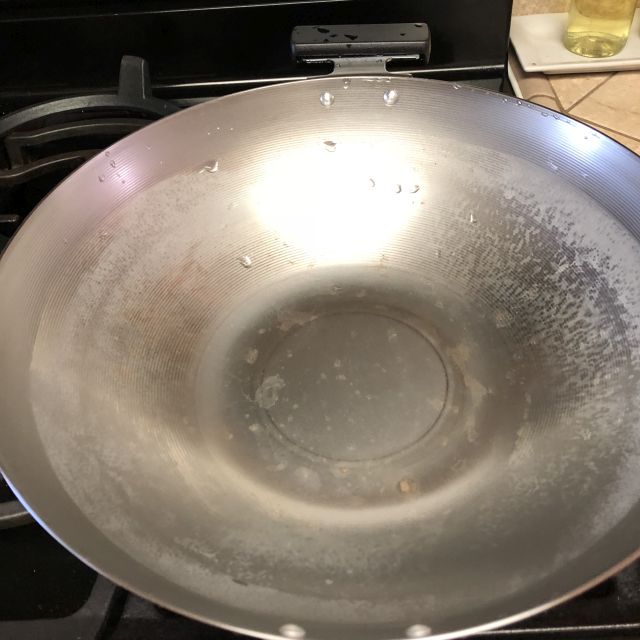
Regardless of washing method, dry the wok over medium or medium-low heat.
Now season the wok to further get rid of any metallic tastes and work oil into the metal crevices. There are many seasoning methods. What you choose depends on ingredients at hand, plus the time you want to invest.
Wok Seasoning Option 1: Stir-fry a bunch of aromatics
Of the many ways to season a wok, the easiest is to stir-fry ginger and green onions. Heat the wok over high heat, then swirl in 2 tablespoons of canola, peanut, or vegetable oil. Then add 1/2 cup sliced unpeeled ginger and 1 bunch of green onions cut into 2-inch sections.
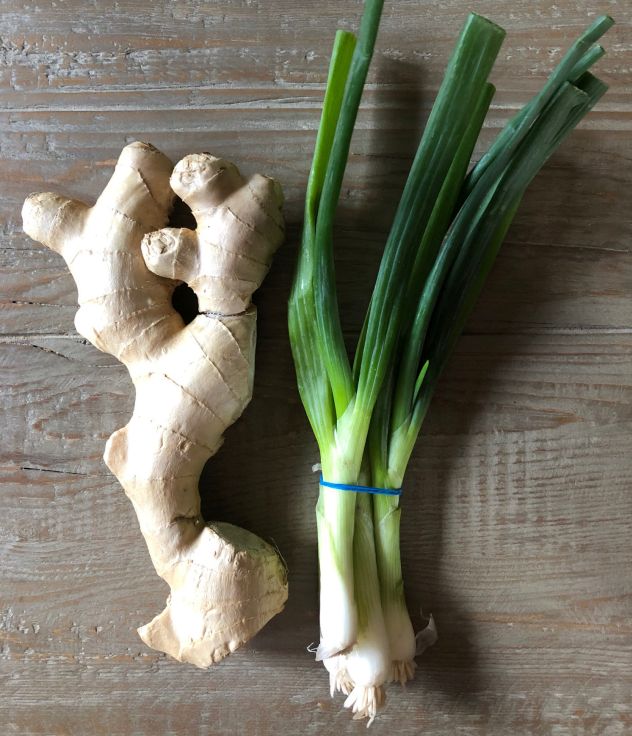
Turn down the heat to medium, then stir-fry for 15 to 20 minutes, pressing the mixture all over the wok’s interior, until the vegetables are dry and crusty. Use a wooden or flexible spatula or turner. Practice your wokking skills!
When done, remove the wok from the heat, let cool, then discard the solids. Rinse (use no dish soap plus a soft sponge) then dry the discolored-but-seasoned wok on the stove. It’s now ready to use.
Wok Seasoning Option 2: Fry potato peels and salt
I’ve used this on a new wok and it’s also good for re-seasoning a sticky old wok. This method is what I’ve used on carbon-steel skillets. The potato peels-and-salt approach works like a charm, especially when you plan to make a potato dish. Save the peels.
What you need: 1/3 cup oil (such as canola, peanut, or vegetable), 2/3 cup table salt or fine sea salt (coarse salt pops and jumps), and the peels of 2 potatoes (any kind).
Put all the ingredients in the washed, dried wok. Cook over medium heat for about 10 minutes, stirring and pressing against the wok walls to the rim, until dark and crisp. I like to press the ingredients up all along the wok interior and let things sizzle. They sometimes stick to the walls so you can let them hang out.

When the ingredients are dark and spent, turn off the heat. Let things cool, then dump out the solids. Rinse the wok, wiping with a soft sponge but use no dish soap. Dry the wok over a medium-low or low flame. Rub in a little oil, if the wok looks like it needs a little something extra. You’re now ready to wok something tasty.
I didn’t invent this method, but rather borrowed it from America’s Test Kitchen. Details are in this prior post.
Wok Seasoning Option 3: Bake the wok
To put a beautiful patina on a wok inside and out, bake it. The oven method is favored by Tane Chan, the owner of the Wok Shop. It’s non-traditional because old-fashioned Chinese kitchens lack ovens. Tane is proudly Chinese American. Of all the methods, it’s my favorite. Two two woks at the top were baked. The process requires time but try it.
After cleaning and drying wok, assess its handles.
Does your wok have plastic handles that can be unscrewed? If yes, remove them with a screwdriver. That was the case with the Joyce Chen wok I bought from Amazon.
If your wok has plastic handles that cannot be removed, like the cast iron wok below from the Wok Shop, wrap the handles in foil. (I tried one covered in foil and one uncovered. One handle eventually cracked during cooking so use foil!) Preheat the oven to 350F with a rack in the center position.
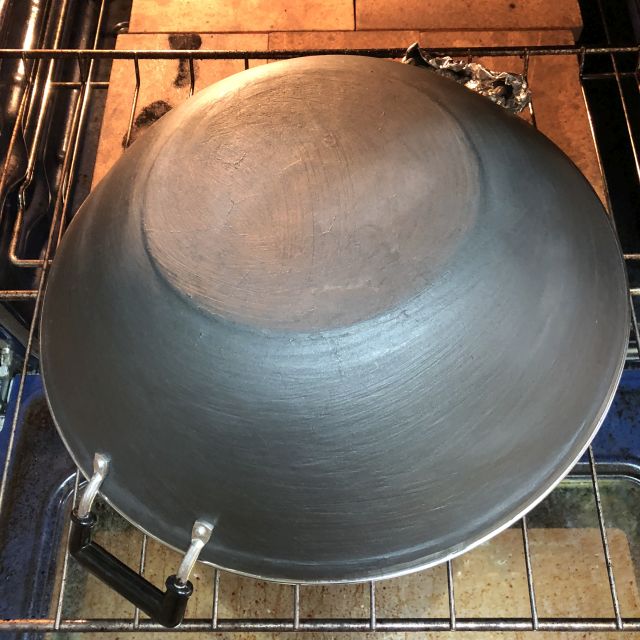
If your wok has a wooden handle(s) that doesn’t budge, like the one on this hand-hammered pow wok, wet a dishtowel or wash cloth and wrap it around the wooden handle. Then wrap it in foil. Repeat if you have another handle. This protects the parts during baking. Preheat the oven 425F with a rack in the center position.
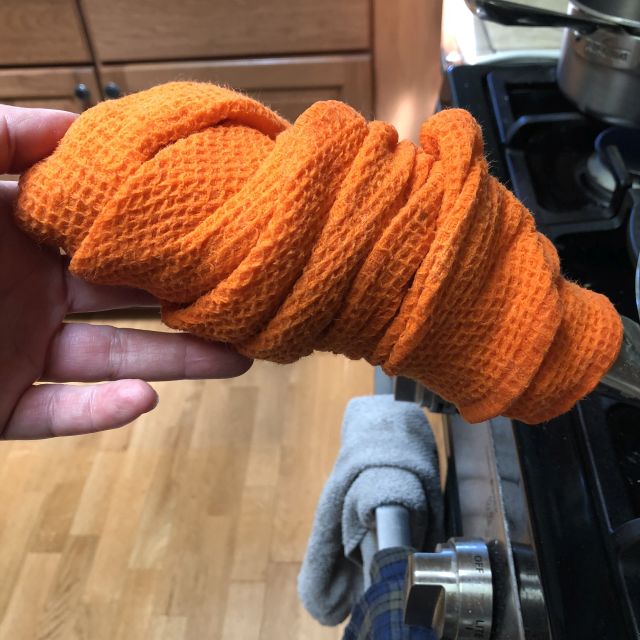
If your wok has metal handles, preheat the oven to 425F with a rack in the center position. Onwards!
Regardless of wok handle type, use paper towel to rub about 2 teaspoons of virgin flaxseed oil or canola oil on the interior and exterior metal surface.
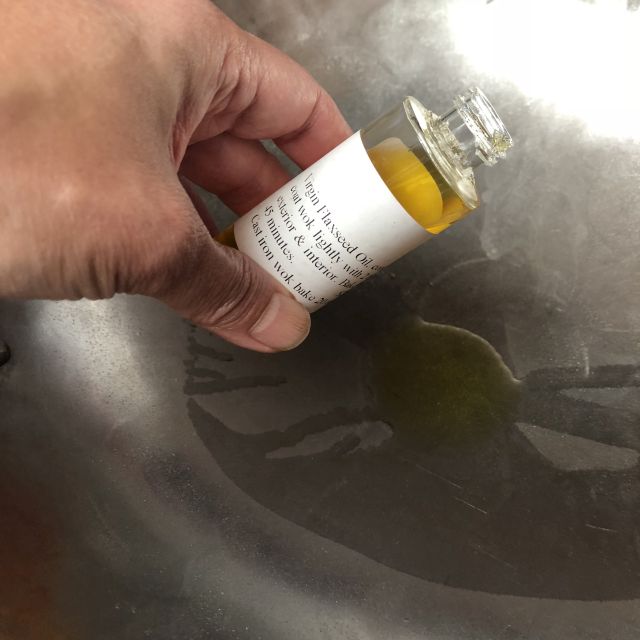
Then invert the wok and place it on the oven rack. Bake it for 30 minutes. Turn off the oven and let things gradually cool for 15 to 30 minutes. This continues the seasoning process and allows the wok to cool so you can retrieve it with few hassles.
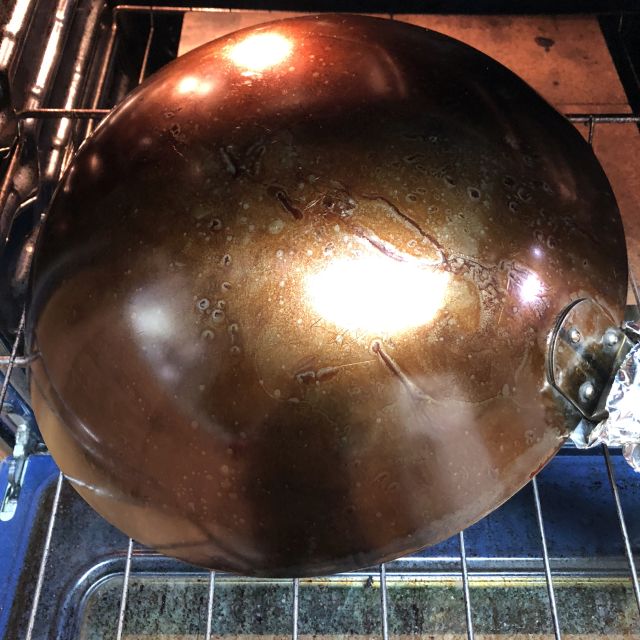
Remove the wok from the oven, then let it cool for about 45 minutes before carefully unwrapping the foil and removing the damp cloth.
Now, heat the wok over medium, add 2 tablespoons of oil (canola, peanut, grapeseed) and 1 large sliced onion. Stir-fry the onion, pressing it all over the interior. After about 10 minutes, when the onions are charred, you’re done.
Discard the onions, wash the wok without dish soap and use the softer side of the sponge. Heat the wok over low for about 2 minutes, until the wok is dry. You’re ready to wok on!
Beyond the first Wok Seasoning
During the first month or two, try to use your wok at least three times a week. You can fry an egg in it, for example. Shallow-fry, pan-fry, deep-fry, stir-fry in the wok. Wash it after each use and in between dishes if you’re cooking consecutive things in the wok. (I do not steam in the wok because that removes the patina.)
Repeated usage allows the wok to further develop its seasoning. Expect the wok to change color during its youth.
Food may initially stick but that’s the nature of your new wok relationship. Over time, you’ll develop a beautiful mature wok that’ll be a workhorse in your kitchen.
More wok tips
- Video tutorials on wok seasoning by Tane Chan of the Wok Shop! (on a gas or electric stove, baked or unbaked)
- My wok buying guide on plus a hack to use a wok well
Note that any links to Amazon on this website are affiliate links. I earn a small referral fee, which I put back into maintaining this site. Thanks for the support.
The post How to Season a Wok? Here are 3 options to consider appeared first on Viet World Kitchen.


